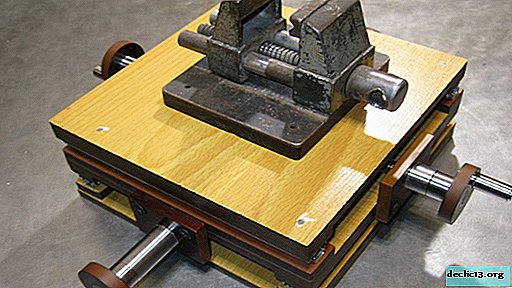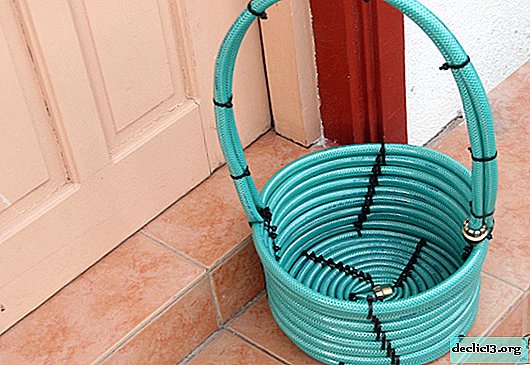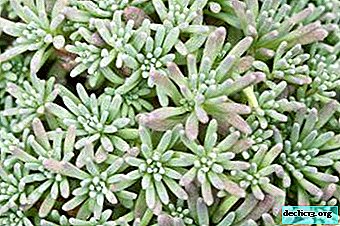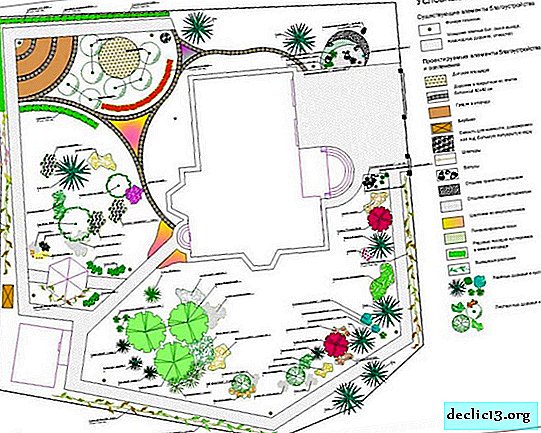White roses Avalange: description and photo of the variety, flowering and use in landscaping, care and other nuances
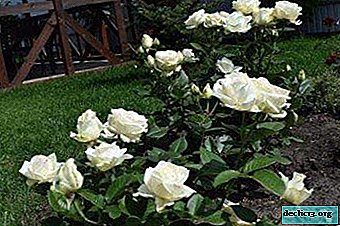
As a result of crossing tea and repair roses, the most sought-after hybrid tea group of flowers appeared. Among the many varieties, the white Avalange variety is distinguished.
These flowers were first bred by a Dutch breeder and are widespread and have good species characteristics. The article tells about how to properly care for, propagate and use this variety of roses in landscape design.
Grade description
Roses are white medium-double flowers. Halfway have a classic form (tea-hybrid) with a high center. Complete dissolution looks like flowers in an open cup-shaped form. The middle can be seen. The diameter of the flower is about 10 cm. One flower grows on one shoot. The bush grows vertically. The height of the bush is 90-120 cm, width - 70 cm.
The foliage is matte, medium green. Average Avalange grade is good. The flower is quite resistant to drought, and during rains some flowers are damaged. The aroma of buds is faint, roses are re-blooming. It shows medium resistance to powdery mildew and black spotting, can hurt in adverse years. Winter hardiness zone 6 (up to -23 ° C).
Photo
Further on the photo you can see how the Avalange rose variety looks like.





History of occurrence
Now on sale you can find Avalange rose for growing in the garden, and gift bouquets of this flower in flower shops. The name of the variety translates as "avalanche". The variety was first bred by Dutch breeders..
The direct creator of the Lex Voorn variety. The breeder has been working with flowers since the age of 15 and he managed to create a really successful snow-white masterpiece that is gaining popularity and recognition in Russia.What is the difference from the rest of the species?
Unlike many other varieties of roses, Avalanche is able to stand cut in a vase for about two weeks. Due to such persistence, these flowers are often chosen in the bride's wedding bouquet. And the delicate emerald border of the petals shades the whiteness of the flower even more spectacularly.
For what purposes is cultivation recommended?
The variety is grown commercially for cut and for sale.. This is called a cut variety. In such cases, the most beautiful buds are left, the rest are removed. Also, a rose is suitable for growing a whole bush in the garden. In this case, she brings flowers again, after cutting.
Bloom
 When and how. Avalange belongs to the re-flowering group of roses. Flowering occurs in the summer.
When and how. Avalange belongs to the re-flowering group of roses. Flowering occurs in the summer.- Care before and after flowering - features. During the growing season, the rose requires the stages of care generally accepted in gardening (watering, top dressing, cultivation, etc.)
- What to do if it does not bloom. Roses may not bloom in the first year, this is considered the norm. Also, flowering may not be due to lack of sunlight (at least 8 hours a day), improper pruning (buds must be removed after flowering), improper feeding, root shoots, bacterial burns, aging (bushes older than 3 years must be rejuvenated).
Use in landscape design
Avalange roses are suitable for a single landing in a prominent place. They can be surrounded by lawn grass and stand out from the contrast of the green grass. Also, roses can be the basis of the composition of the flower garden. A small hedge looks beautiful when several rose bushes are planted in one row. These flowers are suitable for landscape design in the style of rural country, sophisticated Art Nouveau or classic French and English landscape style.
Step-by-step care instructions
Seat selection
The variety develops well in bright areas. This applies to most tea hybrid varieties. When choosing a landing site you need to consider drafts and strong gusts of wind. They should not be.
Timing
In the middle lane and to the north, landing is carried out in the spring (April-May). In autumn, planting is done taking into account the fact that the plant must have time to take root by winter.
The soil
 Soil acidity in the range of 5.3 to 7.3 ph is suitable. Ideal rates from 5.6 to 6.5 ph. For acidification, you can use manure or peat, and for alkalization, lime or ash. The soil should be sufficiently moist and have good drainage.. Clay soil can be improved with peat and sand; sandy soil can be improved with humus, turf and clay. If the groundwater level lies above 1 meter, then the plant may be sick with black spotting.
Soil acidity in the range of 5.3 to 7.3 ph is suitable. Ideal rates from 5.6 to 6.5 ph. For acidification, you can use manure or peat, and for alkalization, lime or ash. The soil should be sufficiently moist and have good drainage.. Clay soil can be improved with peat and sand; sandy soil can be improved with humus, turf and clay. If the groundwater level lies above 1 meter, then the plant may be sick with black spotting.
For planting under a rose bush, a hole of 50-60 cm is dug out and filled with the following layers (bottom): 10 cm of drainage (pebbles, gravel), organic fertilizers (10 cm), garden soil 10 cm.
Landing
Before planting in the ground, seedlings should stand in the water for 4-5 hours. Such moisture saturation will provide adaptability and endurance to plants in a new place. You can treat the seedlings with a root growth stimulator (placed in a solution for a day).
Mandatory transplantation of all shoots and removal of dead sections of the bush. It is convenient to plant a rose with an open root system in this way: the place of grafting the rose by 3 cm hides underground, the roots straighten and sprinkle with soil, the soil around the plant is slightly compacted.
Seedlings are preferably purchased from trusted sellers in nurseries.Temperature
The variety is characterized by good heat resistance. One of the main advantages of Avalange is considered to be a successful wintering. The plant is not afraid of frost and temperature extremes. The variety has excellent frost resistance up to -7 ° C without covering. The minimum temperature is -23 ° C.
Watering
The basis of plant care is mandatory watering. This is especially important during hot and dry periods. Water should not be cold. Consumption is 15-20 liters per bush. In dry, warm weather, this must be done twice a week. Closer to the fall, watering is gradually stopped. It ends completely in September.
Top dressing
In spring, the plant is fed with nitrogen fertilizers. In the summer, potassium and phosphorus are added. The introduction of organic vermicompost or humus is relevant throughout the growing season.
Weeding
Roses need a systematic loosening of soil and weeding from weeds.
Pruning
 To one degree or another, pruning is carried out throughout the growing season. The best time to prune shoots is spring. It is done after swelling of the kidneys. Spring pruning is done to improve flowering and bush formation.
To one degree or another, pruning is carried out throughout the growing season. The best time to prune shoots is spring. It is done after swelling of the kidneys. Spring pruning is done to improve flowering and bush formation.
After planting the seedlings and to rejuvenate the old plant, strong pruning is done (2-4 buds are left). To achieve early flowering and good decorative properties, medium pruning is used in spring. Leaving 5-7 kidneys.
- Preventive pruning in autumn it allows you to remove diseased shoots, defuse bushes and is of a sanitary nature.
- Formative. In summer, faded buds are cut together with the upper part of the shoot in order to regulate flowering (weak pruning). Strong pruning can be used to form and rejuvenate the old bush.
Transfer
An ideal time for transplanting an adult plant is early spring or autumn. In summer, the bush is transplanted in cloudy weather and is trimmed. The plant is removed from its original location with an earthen lump. All buds are removed from a blooming rose before transplanting.
Preparation for winter
In winter, roses are necessarily insulated in one of the ways: you can pour 20-30 cm of soil onto the root system, cover it with a dense non-woven covering material, and cover it with a layer of peat. In spring, the flowers must be opened so that they are not overtwined. Shelter will be required after a steady cooling below -7 degrees.
Before you cover, roses prune and spud soil. Spruce branches can be placed between the bushes and on top of the plants themselves. After that, the frame is set to a height of 20-30 cm and covered with a covering material. Polyethylene spreads on top, and air remains on the sides. In the spring, you can open the structure from the sides for ventilation.
Breeding
Propagation by cuttings will save all the properties of the variety. This method is otherwise called vegetative. Cuttings for propagation are selected from healthy young bushes, after the first wave of flowering has passed. In central Russia, this is usually the period from mid-June to mid-July.
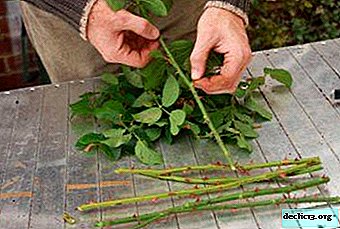 At the cut shoot, the upper soft part is removed, a solid base is left. There should be two sheets on the handle. The bottom cut is 45 ° under the bottom sheet, the top at a distance of 5 cm from the top sheet.
At the cut shoot, the upper soft part is removed, a solid base is left. There should be two sheets on the handle. The bottom cut is 45 ° under the bottom sheet, the top at a distance of 5 cm from the top sheet.- The dried cuttings are planted in the soil to a depth of 2-3 cm in a cool place in the shade.
- Water and cover with a jar or a bottle.
- Periodically, the plant is sprayed.
If the stalk has taken root, then for the winter it should remain in the same place under shelter. It will be possible to transplant in the spring.
Propagation by lignified cuttings is possible.. In the fall, shoots are cut off and then stored all winter in a humid environment in the cold. Then cut into cuttings and root in the usual way. Planting young growths in the sand will reduce the risk of diseases that are in the soil.
If the rose gave roots while in winter storage, then these instances can immediately be planted in a pot.Another popular way to propagate roses is to propagate by layering. The selected shoot is bent to the ground, fixed and dug up with the ground. By autumn, rooting should take place, then this plant is left in the same place for the winter and planted only when spring comes.
Diseases and Pests
The variety is medium resistant to powdery mildew and black spotting.. The rose is struck by rust, gray rot, spider mites, green rosacea aphids, rosette leaflets, rosaceous insects, bear cubs, drooling pennies.
Roses look great on any garden plot. They can form the basis of the flower garden or stand out against the background of the lawn. Variety Avalange is resistant to climate change and the main diseases of roses. Cut flowers can stand in a vase for at least two weeks and exude a delicate floral aroma.

 When and how. Avalange belongs to the re-flowering group of roses. Flowering occurs in the summer.
When and how. Avalange belongs to the re-flowering group of roses. Flowering occurs in the summer. At the cut shoot, the upper soft part is removed, a solid base is left. There should be two sheets on the handle. The bottom cut is 45 ° under the bottom sheet, the top at a distance of 5 cm from the top sheet.
At the cut shoot, the upper soft part is removed, a solid base is left. There should be two sheets on the handle. The bottom cut is 45 ° under the bottom sheet, the top at a distance of 5 cm from the top sheet.